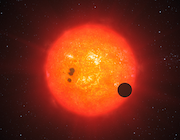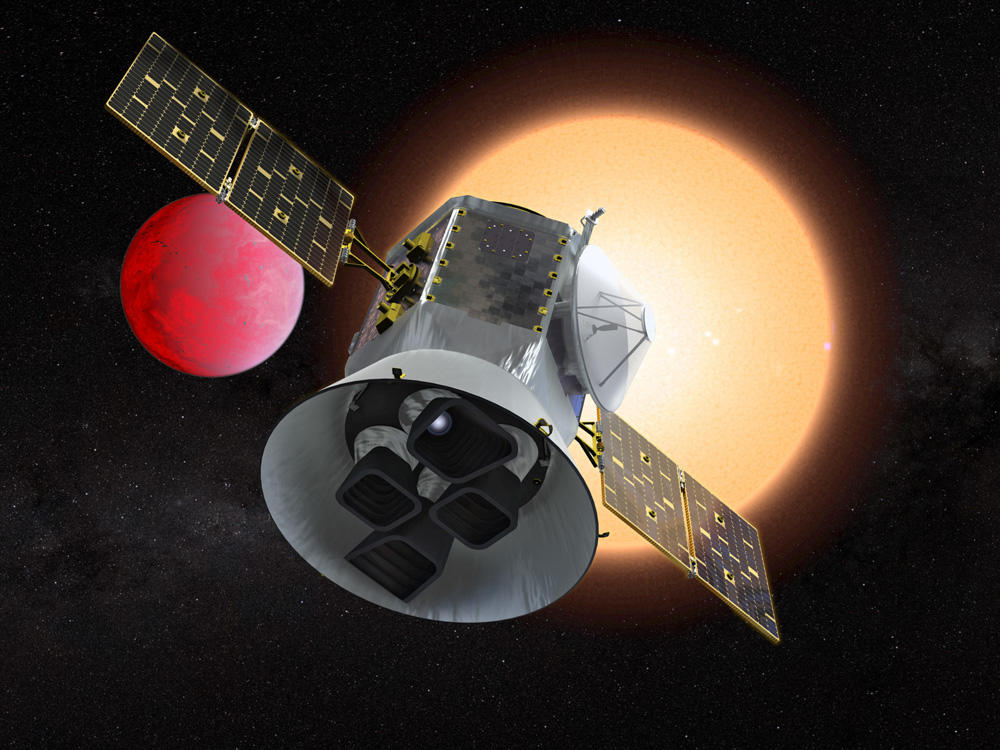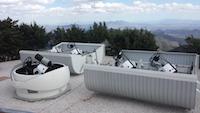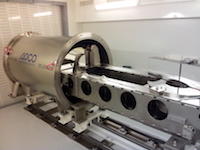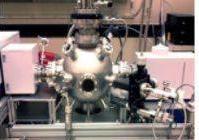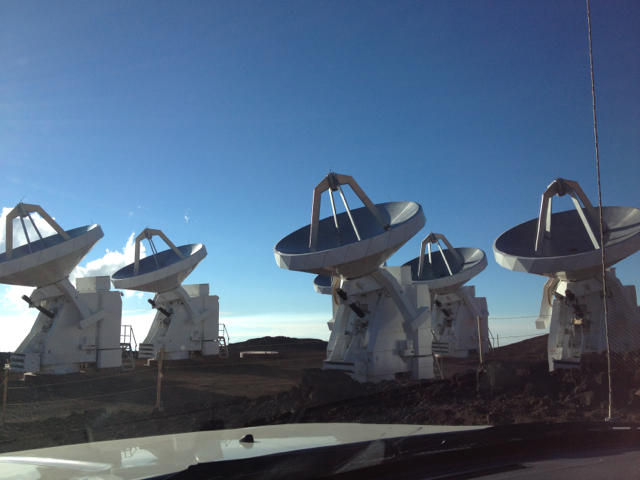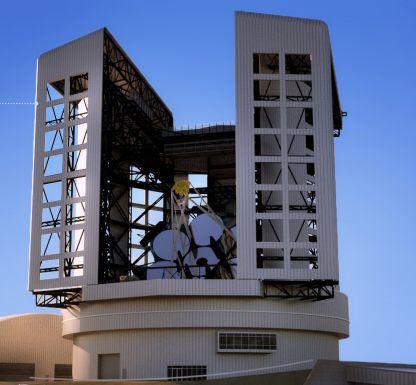The Transiting Exoplanet Survey Satellite (TESS) Mission is led by the Massachusetts Institute of Technology (MIT), which is responsible for the overall direction of the mission. The TESS Science Office (TSO) is a partnership between MIT's Physics Department and Kavli Institute for Astrophysics and Space Research and the Smithsonian Astrophysical Observatory. The TESS Science Office analyzes the science data and organizes the co-investigators, collaborators, and working groups.
The MEarth Project (pronounced "mirth") is an astronomical survey that is using robotic telescopes to observe nearby M dwarf stars in search of new Earth-like exoplanets. The MEarth-North telescope array observes from the Fred Lawrence Whipple Observatory (FLWO) on Mount Hopkins, just south of Tucson, Arizona. The MEarth-South telescope array observes from the Cerro Tololo Inter-American Observatory(CTIO) on Cerro Tololo, just east of La Serena, Chile.
The MINiature Exoplanet Radial Velocity Array (MINERVA) is an array of small-aperture robotic telescopes outfitted for both photometry and high-resolution spectroscopy located at the Fred Lawrence Whipple Observatory at Mt. Hopkins, Arizona. It is the first U.S. observatory dedicated to exoplanetary science capable of both precise radial velocity and transit studies.
The High Accuracy Radial velocity Planet Searcher HARPS-N spectrograph is a high-precision radial-velocity instrument located in the Northern hemisphere and installed at the TNG on La Palma Island (Canary Islands) to allow for synergy with the NASA Kepler mission. The main scientific rationale of HARPS-N is the characterization and discovery of terrestrial planets by combining transits and Doppler measurements.
The Öberg Astrochemistry Group uses astronomical observations, laboratory ice experiments and astrochemical theory to explore the chemistry of star and planet formation. They use a specially designed ultra-high vacuum surface science set-up to investigate chemistry in ices and grains in the interstellar medium.
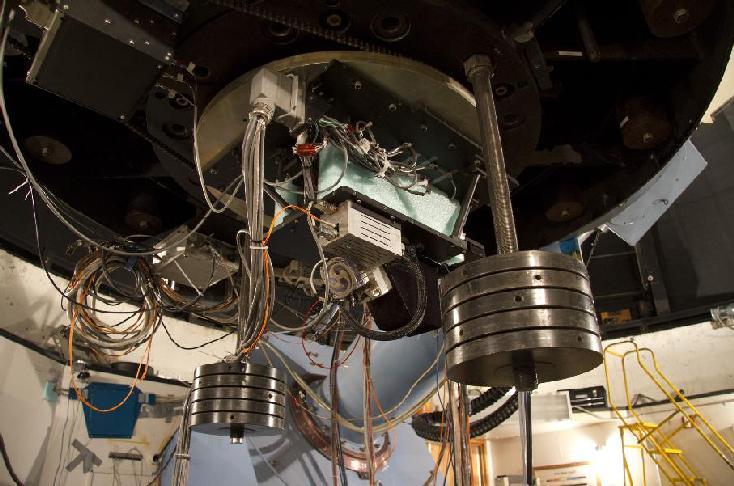 Tillinghast Reflector Echelle Spectrograph (TRES)
Tillinghast Reflector Echelle Spectrograph (TRES)![]()
The design is a high-throughput fiber-fed echelle. It is cross-dispersed, yielding a passband of 390-910 nm. It accommodates 3 optical fiber pairs (science+sky) and offers 3 resolutions, 60K, 48K and 30K.
The 6.5-meter Baade and Clay telescopes were built by the Carnegie Institution of Washington at its Las Campanas Observatory in Chile on behalf of the Magellan Project, a collaborative effort by the Carnegie Institution, University of Arizona, Harvard University, University of Michigan, and Massachusetts Institute of Technology. The Magellan Consortium consists of more than 400 astronomers.
The Submillimeter Array (SMA) is an 8-element radio interferometer located near the summit of Maunakea in Hawaii. Operating at frequencies from 180 GHz to 420 GHz, the 6 m diameter dishes may be arranged into configurations with baselines as long as 509 m, producing a synthesized beam of sub-arcsecond width. Each element can observe with two receivers simultaneously, with up to 8 GHz bandwidth each per sideband. The digital correlator backend provides a uniform resolution as high as 140 kHz.
Coming Soon...
The Giant Magellan Telescope will be one member of the next generation of giant ground-based telescopes that promises to revolutionize our view and understanding of the universe. It will be constructed in the Las Campanas Observatory in Chile. Commissioning of the telescope is scheduled to begin in 2027.
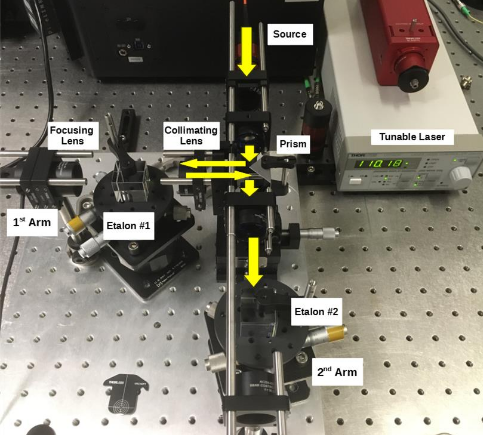 FIOS
FIOS
The Fabry Perot Instrument for Oxygen Searches in Exoplanet Atmospheres (FIOS) will distinguish between abiotic O2 formed from H2O photolysis in the upper atmosphere, and well-mixed biological O2. FIOS can achieve a spectral resolution of 500,000 at the O2 A-band (760 nm). It is optimal for O2 detection, while maintaining a higher through- put compared to instruments with similar spectral re- solving power.
The GMT-Consortium Large Earth Finder (G-CLEF) is a cross-dispersed, optical band echelle spectrograph to be delivered as the first light scientific instrument for the Giant Magellan Telescope (GMT) in the mid 2020's. G-CLEF is vacuum-enclosed and fiber-fed to enable precision radial velocity (PRV) measurements, especially for the detection and characterization of low-mass exoplanets orbiting solar-type stars.
 Tierras Telescope
Tierras Telescope
The Tierras Telescope located at the Fred Lawrence Whipple Observatory![]() (FLWO) on Mount Hopkins, just south of Tucson, Arizona will detect nearby transiting planets and follow-up of planets discovered by TESS and other surveys. It includes an ultra-precise phtometer that will regularly achieve <700 ppm precision.
(FLWO) on Mount Hopkins, just south of Tucson, Arizona will detect nearby transiting planets and follow-up of planets discovered by TESS and other surveys. It includes an ultra-precise phtometer that will regularly achieve <700 ppm precision.
